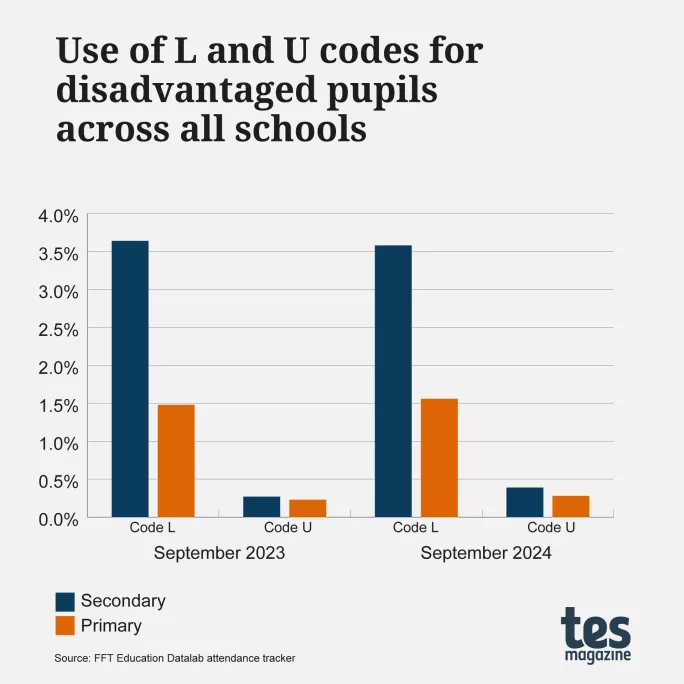New register rules could make attendance issues ‘worse’

Changes in how schools have been told to record lateness from this academic year risk making the pupil attendance crisis worse, according to school leaders and sector experts.
Concerns have also been raised that the changes could make data on absence unreliable.
The issue relates to the “L” and “U” codes for recording attendance. From August, statutory government guidance was changed to remove a clause that enabled schools to mark a pupil as L if they arrived during the “length of form time” or the “first lesson in which registration takes place”, which could have been up to an hour or more after the start of the school day.
Schools now have to use a U code - unauthorised absence - if a pupil arrives after the maximum 30-minute window that registration can be open, with no exceptions.
A Department for Education spokesperson told Tes that the new rules ensure “consistency across the country” and “clarity and fairness for families”.
“A pupil who is late 30 minutes every day misses the equivalent of almost half a day of school each week compared to their peers,” the spokesperson said.
Frustration over attendance code rules
However, school leaders and researchers have raised concerns about the impact of the change just half a term into the new academic year.
Professor John Jerrim, of University College London’s Institute of Education, who has researched the link between absence and GCSE outcomes, warned that if “lateness is penalised too harshly it could lead to students who are running late to not bother showing up at all”.
“This would then not be improving the situation - it would just be making matters worse,” he said.

Dave Whitaker, chief education officer at Wellspring Academy Trust, a trust of 32 schools including eight alternative provision settings and nine special schools, said the attendance code changes had not been “thought through” by the government, particularly in relation to how they could impact the most vulnerable children.
He argued that schools need to be able to identify where “genuine obstacles” to attendance arise for their pupils and to record that in registers appropriately. For example, this could include a young carer arriving late because their parent’s health condition required extra support that morning.
These types of cases should “not result in a code that penalises the pupil or the school”, Mr Whitaker said.

Meanwhile, Stephen Steinhaus, CEO of Solihull Alternative Provision Multi Academy Trust, which has three schools in the West Midlands, said that the attendance code changes are making teachers’ jobs “more difficult” and putting relationships with families in jeopardy.
“It is not the kind of policy to introduce when the fabric of going to school is being questioned,” he told Tes. It is also not “the message we want to send to families”, he said, adding that pupils are “penalised for showing up”.
This view is shared by many in the alternative provision and specialist sector, according to Rob Williams, senior policy adviser at the NAHT school leaders’ union.
“We have heard particular concerns from special schools, where there can be very legitimate reasons for pupils being late after the registers close,” he said.
Sarah Johnson, president of the National Organisation of Pupil Referral Units and Alternative Provision, known as PRUsAP, agreed, stating that “the idea that children are classed as absent when they may have a valid reason to come into school after registration closes is a huge concern”.
Fears have also been raised about the reliability of absence data as a result of the changes. Mr Whitaker said his trust is having to “collect shadow data to ensure we have an accurate reflection of our own data, which is adding to teacher workload”.
- School attendance: 32,000 pupils on part-time timetables
- Pupil absence: Scale of attendance issue requires a sector-wide approach
- Policy: Restore expert group to tackle absence crisis, DfE urged
And Warren Carratt, chief executive officer of Nexus MAT, a trust of 17 schools in South Yorkshire and Nottinghamshire, said “there’s a risk that [the new guidance] exaggerates the issue” of absence.
He said that the current guidance “muddies the water more than clarifies it”.
“It’s a shame because I think the intent was to try and get a much firmer grip over what the actual state of attendance and absence looks like,” he added.
Data on absence codes used in the first month of the term reveals a small rise in Code U use in secondary schools among students eligible for free school meals and those with an education, health and care plan, compared with September 2023, according to FFT Education Datalab.
But it shows more of a mixed picture in primary schools, with both Code L and Code U usage among the same pupil groups increasing year on year.
School leaders have suggested that some schools have been approaching the guidance more loosely and have been using a Code L in scenarios that, under current guidance, require a Code U - for example, recording a pupil as Code L when their bus has been delayed and the pupil won’t be arriving until after the registration window has closed.
Mr Steinhaus said that the new rules risk “incentivising schools to manipulate the system”.
For the latest education news and analysis delivered every weekday morning, sign up for the Tes Daily newsletter
Keep reading for just £1 per month
You've reached your limit of free articles this month. Subscribe for £1 per month for three months and get:
- Unlimited access to all Tes magazine content
- Exclusive subscriber-only stories
- Award-winning email newsletters
topics in this article



